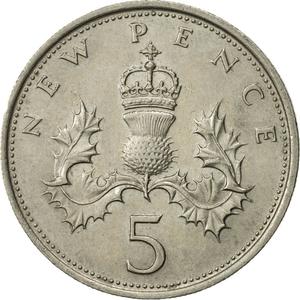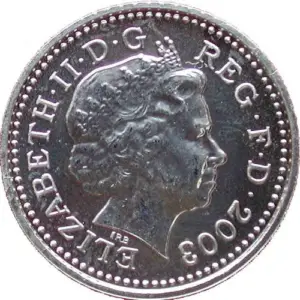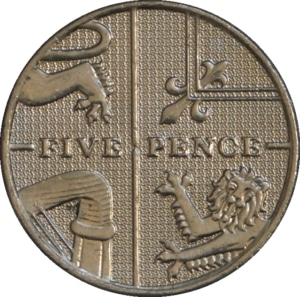The 5p coin was first introduced in 1968 with the intention of eventually replacing the shilling, and the coin has undergone many changes since this date.
The biggest change to the 5p occurred in 1990 when the coin was altered in size from around 25.6mm to 18.0mm. Another significant change occurred in 2012 when the 5p started to be produced in nickel-plated steel rather than cupro-nickel, which saw the thickness of the 5p increase slightly.
In this article, we’ll cover these changes and address some commonly asked questions about the old (and new) 5p coin – let’s get straight into it.
Why Was The 5p Coin Introduced?
In the 1960s it was decided that the UK’s currency system would benefit from being decimalised and that the official change to the currency system would happen on 15th February 1971, known as Decimal Day.
Prior to Decimal Day, 1 British pound was made up of 20 shillings, each of which consisted of 12 pence hence making the pound worth 240 pence in total. It was decided that the new pound would instead be made up of 100 pence, hence making the shilling equivalent to 5 pence.
Old denomination coins such as the shilling would be withdrawn in favour of more obvious coins such as the 5p and the 10p coin.
The 5p coin was the same size as the shilling to make it clear that they had equal value, although they featured a new design of a crowned Scottish thistle.
It was known that this change would be difficult for the British public to come to terms with straight away, so the shilling was kept in circulation alongside the new 5p coin up until 1990 with its updated value of 5 pence.
Since then, it is estimated that over 370 million 5p coins have been minted and entered circulation.
What Changes Have Happened To The 5p Coin?
Since it was first introduced in 1968, the 5p coin has undergone several changes to both its size and design. We’ve outlined every version of the 5p coin that has ever entered circulation and the changes that were made.
The First 5p Coin (1968-1981)
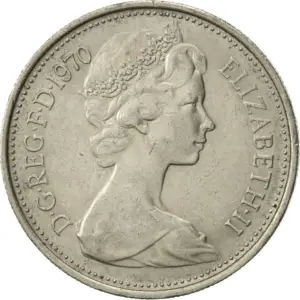
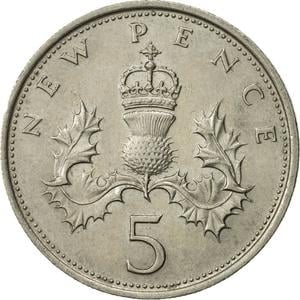
The very first 5p coin design to be released featured a reverse design by famous coin designer, Christopher Ironside. The design was of a crowned Scottish thistle with the numeral ‘5’ at the very bottom. The inscription across the top of the coin read ‘NEW PENCE’ to reflect the new decimalisation of the UK’s currency system.
The obverse of the coin had Arnold Machin’s portrait of The Queen which was commissioned to help the newly introduced coins stand out from their pre-decimalisation counterparts.
The size of the 5p coin was the same as the size of a shilling to make the transition to the new decimalised system easier for the British public.
Removal Of ‘New Pence’ (1982-1984)
In 1982, the top inscription of the reverse design was finally changed from ‘NEW PENCE’ to ‘FIVE PENCE’ to better reflect the value of the coin. The numeral inscription ‘5’ remained on the design despite the change.
The obverse remained as Arnold Machin’s portrait of The Queen.
Change Of Obverse (1985-1990)
In 1985, the official portrait of The Queen that was to be included on coins was changed to a new design by sculptor Raphael Maklouf. The obverse of the 5p coin was included in this update marking the first significant change to the coin’s design.
Maklouf’s portrait of The Queen was intentionally flattering and was meant to be an ‘ageless’ depiction of her. The reverse design of the 5p coin remained unchanged.
New Coin Size Introduced (1990-1997)
A new, smaller-sized 5p coin was officially introduced in the UK’s currency system in June 1990 after it was decided that the still circulating shilling would be withdrawn later in the same year.
This new size for the coin made it more distinctive and the old-sized 5p coins were demonetised in December 1990, and this is the year people most often associated with the biggest change to the 5p coin since its introduction.
The reverse and obverse designs of the coin remained unchanged during this time.
Obverse Changed Again (1998-2008)
The obverse design was once again changed in 1998 to the new bust design by Ian Rank-Broadley. The portrait design is noted to be more realistic than its predecessor with Rank-Broadley claiming there was ‘no need to disguise the matureness of The Queen’s years’.
The size of The Queen’s portrait relative to the coin was significantly increased to ‘maximise its impact’ on smaller coins like the 5p.
All other aspects of the coin remained unchanged.
Coat Of Arms Design Introduced (2008-2015)
After 40 years of the classic thistle design, the reverse of the 5p coin was finally changed in 2008. The new design, which continues to be minted to this day, is part of a contemporary design set that involves all the coin denominations from 1p to £1.
When all coins are arranged in their correct positions, their combined reverse designs form the image of the Royal Coat of Arms of the UK.
The 5p coin holds potentially the most important piece of the puzzle and is the very centre of the Royal Coat of Arms where all four segments meet. The inscription ‘FIVE PENCE’ lies across the centre of the coin in place of the horizontal division on the shield.
From 2008 to 2015, the obverse remained as Ian Rank-Broadley’s portrait.
Change Of Metal (2012)
In 2012 the Royal Mint made the decision to produce both 5p and 10p coins in nickel-plated steel rather than cupro-nickel.
This was a cost-saving effort and was estimated to save the treasury £7-£8 million per year. The downside to this decision was that these new coins were easier to forge, however, it was argued that it would not be worthwhile to forge such low-value coins and hence this argument was ignored,
The impact of the new composition means that 5p and 10p coins minted from 2012 onwards are magnetic, and also slightly thicker as nickel-plated steel is less dense than the cupro-nickel used previously.
To make the weights equal, something that is important for banks when weighing coins, the thickness of the 5p changed from 1.7mm to 1.89mm.
Final Change To The Obverse (2015-current)
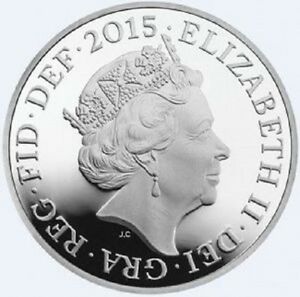
The most recent change to have been made to the 5p coin was another update to the obverse design. The new portrait by Jody Clark was introduced in 2015 and continues to be minted on new coins as of now. The design shows a smiling Elizabeth II in a more defined portrait than used previously.
The reverse design continues to be the Royal Coat of Arms centrepiece.
FAQs
Are 5p Coins Still In Circulation?
5p coins are still in circulation to this day, although their application in daily life is becoming more limited due to inflation and the popularity of contactless payments.
The most recent mintage figures for the 5p coin were 49,200,000 in 2020 and 92,800,000 in 2019.
What Is A 5p Coin Made Of?
Prior to January 2012, the 5p coin was made from cupro-nickel, an alloy of copper that contains 75% copper and 25% nickel.
Since this time, the 5p coin has been made from nickel-plated steel.
Is A Shilling 5p?
The 5p coin was issued to replace the shilling, and both coins were in circulation between 1968 and 1990, but they were not the same coin.
You can think of a shilling as a pre-decimal 5p and vice versa.
Final Thoughts
The 5p coin has undergone many changes during its short history as a coin, with many of the versions still a part of active circulation. Don’t forget to check out our guide to the coin’s predecessor, the shilling.
If you have any questions about the content mentioned in this article, please contact us here.
